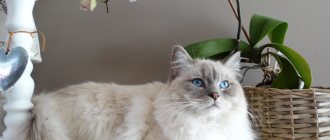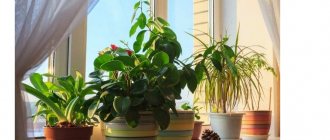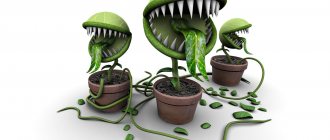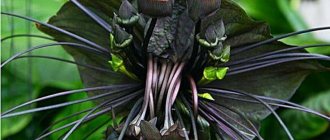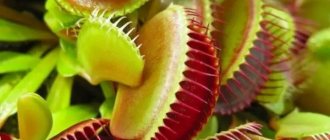Many plants found in the home are poisonous to cats.
Caring for a cat involves not only making healthy food choices and regular visits to the vet, but also making sure your home is completely safe for your cat. An inquisitive pet will search everywhere and willingly try plants that may be poisonous to him. Read our article to find out which plants should not be within reach of your little friend. We'll also tell you which safe indoor plants can brighten up your home.
Poisonous plants for cats - what symptoms occur after ingestion?
Potted plants make a home feel cozier and the layout more interesting. However, visual considerations are not the most important thing, especially if you have a cat - it turns out that flowers can be very harmful to your pet. Do you think that your cat is not interested in plants, so they can be left out of the house? This is incorrect thinking because for some plant species, just trying a small amount once is enough to cause irreversible changes in the small organism.
Poisoning from toxic plants causes drooling, diarrhea, lethargy, abdominal pain, lack of appetite, seizures and even death. A bite from the plant may cause immediate symptoms or lead to poisoning only after some time. Dangerous plants cause the cat’s kidneys to work worse and worse, and the heart has an abnormal rhythm. Therefore, do not take risks and check all the plants that you have at home, and in this way you will protect your pet from poisoning.
Symptoms of toxic plant poisoning:
- salivation,
- diarrhea,
- abdominal pain
- lack of appetite
- convulsions,
- no desire to play
- kidney or liver weakness
- acceleration or deceleration of heart rate.
Some indoor and garden plants are very poisonous to cats.
Lilies are poisonous plants for cats
Poisonous plants are those that you know well, you like their smell, and you watch them grow on your windowsill. One of the most poisonous flowers for pets are flowers of the lily family , which are highly toxic and, interestingly, can cause unpleasant symptoms not only in animals, but also in people. If the lily is part of a bouquet decorating your home and you have a cat, discard this dangerous decoration. Both petals and stamens or stems, and even fine pollen, are toxic to these flowers.
Lilies are highly nephrotoxic, meaning they destroy the kidneys. In addition to the usual symptoms that may occur with poisoning, your cat may become thirsty. This will not escape your attention, because wallets rarely end up in a bowl of water. By nature, they do not drink much, but rather eat water from their food. After eating any part of the lily, you may experience abdominal pain due to enlargement of the kidneys.
- The lily family is harmful to cats because it is nephrotoxic. Kidney problems may occur after eating the petals, stamens, stems or pollen because every part of the lily is toxic.
Beautiful lilies that decorate home windowsills and gardens can become dangerous if they are consumed not only by a cat, but also by a person.
How to keep your pet safe
The best way, of course, is to replace dangerous plants with safe ones, but there are other options:
- Place potted plants on high shelves and other places where the cat cannot reach them.
- Offer the animal an alternative in the form of special grass for cats.
- Wean your pet from the habit of chewing leaves.
- Buy vitamins for animals. Perhaps the animal still consumes them due to a lack of any vitamins.
If there are still poisonous plants in your home, keep an eye on your pet and its health. At the first sign of unwellness, contact your veterinarian immediately.
Make it a habit to always check whether a plant is dangerous for your pet before purchasing.
As you can see, even indoor flowers that are familiar to everyone can cause harm, and if this has not happened so far, no one can be sure that it will never happen.
Spathiphyllum and cat - what do you need to know?
Spathiphyllum is a plant that is characterized by brightly shiny green leaves and white flowers. Many people like it because it can clear the air of alcohol vapors found in perfumes or harmful substances that come from cigarette smoke. Unfortunately, spathiphyllum is largely poisonous to cats, so if you have a pet, get rid of the plant as soon as possible.
Spathiphyllum is dangerous for cats due to substances that irritate the mouth and cause a burning sensation in the stomach. Symptoms of plant poisoning are, first of all, vomiting, lack of desire to play, aversion to food, but, unfortunately, death. The flowers, rhizomes, shoots and leaves are highly toxic, so there is no place for a flower in the home of a responsible cat lover.
- Unfortunately, the poisonous spathiphyllum is extremely dangerous for cats, so its consumption can even lead to the death of a pet. Substances contained in the plant irritate the stomach and cause a burning sensation.
This plant is preferred for home windowsills, but unfortunately, it is poisonous to cats.
Why do cats eat grass?
The little predator is not averse to eating vegetation for several reasons:
- Cleansing the stomach, normalizing the gastrointestinal tract. Fluffy neaties carefully lick their fur. Many hairs enter the body. They are not digested and form lumps. They can cause harm to the pet’s health and cause discomfort. This is where green grass comes to the rescue. It helps get rid of unnecessary hair in the stomach.
The grass gets inside and provokes a gag reflex.
The body naturally frees itself from gastric “blockages” - hairballs and fluff.
A cat that lives outside the city, in a private house, arranges a “cleaning” for itself. She finds grass as soon as she feels a heaviness in her stomach.
After consuming the plants, the functioning of the gastrointestinal tract is normalized, and peristalsis is activated.
- Improve your health. Animals instinctively know which grass to chew . By eating certain plants they try to get rid of the disease. Herbs help cure stomach diseases, poisoning, and get rid of parasites.
- Replenish vitamin deficiency. Although a cat is a carnivore, in addition to meat food, it needs fiber and vitamins. Animals obtain deficiency of essential substances and minerals from vegetation.
- New tastes. Sometimes the mustache does not eat grass, but only chews. Experts suggest that they like the taste of it. Chewing juicy grass gives them pleasure.
If your cat eats too many greens, this is a warning sign.
It's better to consult a veterinarian. Perhaps the mustachioed pet lacks some vitamins and minerals.
In the worst case, a strong passion for grass may indicate the presence of a hidden disease in your pet.
Is lavender poisonous to cats?
Lavender adorns many gardens, but it can also be grown indoors. It is distinguished by its purple color and unusual aroma that repels mosquitoes. Do you want to start growing this plant and wonder if lavender is dangerous for your cat?
Opinions about this flower are divided. Some sources mention that lavender is poisonous to cats and consuming it can cause nausea, vomiting and lack of appetite. The scent of purple flowers is often recommended as a repellent. On the other hand, it appears to be a scent additive for gravel and collars used to relieve stress in cats.
The lack of reliable sources means you must make decisions on your own, which can be risky. Inhaling the scent of lavender should not cause any symptoms in your cat, but consuming it regularly may be harmful. As often happens, too high a dose makes the species toxic.
- The answer to the question of whether lavender is poisonous to cats is unclear. Some sources confirm that the purple flower can cause vomiting and loss of appetite, but the scent has been found in products intended to "purr", such as pheromone collars.
It is recognized that lavender flowers can cause symptoms of poisoning in cats.
Healthy greens for cats
How lucky are cats living in rural areas? In the warm season, the owner can let the cat out into the garden, and there it will be full of delicious herbs that will cleanse the body and cure ailments. City cats quietly mutter on the sidelines; they are deprived of such luxury.
But a loving owner can grow these green “dishes” on his windowsill and arrange a kind of green garden for his beloved cat. This home garden will contain only safe plants. Which?
- Melissa;
- wheat;
- oats;
- barley;
- mint (field and watermint);
- ivy-shaped budra.
The cat will thank you very much for these goodies.
Bromeliad - is it poisonous?
A plant from the pineapple family is called guzmanania. Its leaves can have different shades - green, burgundy, brown. The flowers, however, take on a bright, red or orange color. Bromeliads are different in that they dry out after releasing the flower, which is a natural process.
Bromeliads are described as non-toxic to cats, so you can decorate your home with them if you have a pet. Do you want her to look beautiful for as long as possible? Place it out of the cat's reach and take additional care to keep the soil moist and regularly misting the leaves, but not the flowers. Guzmania requires a warm location and sunlight, but do not expose it to direct contact with intense sunlight as this may damage the delicate flower.
- Bromeliads are considered safe for cats. A plant from the pineapple family needs a moist substrate, frequent spraying and a warm place.
Use of special means
At the pet store you can purchase special preparations that help protect flowers from cats.:
Read also Baked eggplants for the winter for freezing
As a rule, the preparations are sold in the form of a spray, which is sprayed onto the surface of the soil and next to the pot where the flowers grow. If the animal is already old, it is better to use other methods so as not to provoke allergies, painful reactions from the bronchi, etc.
The use of substances with a pungent odor (vinegar essence, medical alcohol, vodka, etc.) is also undesirable. This poses a threat to both the health of the cat and the growth of flowers.
Yucca
Yucca is a fairly large houseplant that is popular because it is easy to grow, beautiful in appearance, and has low requirements. You will recognize it by its trunk, overgrown with leaves arranged in a trail. Are you wondering if yucca is poisonous to cats? Unfortunately, yes, so if it decorates your home, get rid of it as soon as possible.
Until recently, it was believed that only garden yucca was harmful to cats, but it turns out that the house plant is also toxic. The dangerous ingredient is saponins. Ingestion of this plant by a cat can lead to vomiting, which in turn leads to dehydration, which is extremely dangerous.
- Yucca is dangerous for cats because of its saponins. Ingestion of the plant may cause vomiting, and it will dehydrate your pet.
Flower poison in the cat's body
Toxins tend to accumulate in the body and, when reaching a critical amount, cause damage. It often happens that a cat regularly chews several leaves while the owner is busy with important matters. And the pet’s behavior does not reveal its pranks for a long time. The cat is healthy and cheerful, but for the time being. Every leaf can be the last.
Flower poison destroys the animal’s body, leading to such terrible conditions as laryngeal edema, gastrointestinal upset, and heart rhythm disturbances. If the body is weak, or too much flower is eaten, the pet may stop breathing.
Ficus
Ficus is an ornamental plant that decorates many homes. It has gained recognition due to the lack of difficulties in growing and its appearance, which can diversify even the simplest interiors. The houseplant, also known as ficus, comes in many varieties.
Any variety of this plant will irritate both your skin and the mucous membranes of your pet's digestive tract.
- Easy to grow, ficus comes in many varieties, all of which are dangerous for cats. It can irritate your pet's skin and digestive tract.
All varieties of ficus are poisonous to cats.
Rue - cats don't like its smell
Common rue grows up to a meter in height and its flowers are small and yellow. The plant is not used to decorate houses, but it is used in herbal medicine. However, this is not the only function that a regular root can perform. Cats don't like its smell, so many people grow it in the garden to scare away unwanted guests.
Is your home visited by your neighbors' pets and are you concerned about the health of your cats? Then take care of your health and get ordinary rue, which will scare off uninvited guests with its aroma. Lavender will work in a similar way, but not all cats will bypass it.
- Common rue is a plant that decorates gardens and is used in herbal medicine. Cats don't like its smell, so you can sow it on your property to deter intruders.
How to Grow Cat Grass at Home
It is quite possible to create a green lawn at home, on the windowsill. After all, domestic cats do not have the opportunity to go outside and “get caught.” It is preferable to choose cereals, lemongrass, and catnip.
Seeds are purchased at a pet store.
The green delicacy is grown hydroponically in the ground. The seeds are placed in a substrate and covered with film. When shoots appear, it is removed.
After 4-6 days, the grown-up “treat” is offered to the pet.
Safe indoor plants for cats - do they exist?
Are you under the impression that you have to go completely green at home to keep your pet safe? This is wrong! Flowers that are safe for cats also exist, and their appearance is no different from toxic species.
Safe potted flowers are ferns, more precisely the haughty nephrolepis , with which you can decorate your home. This beautiful plant will look great hanging from the ceiling, but it can also stand in a pot. The plant is non-toxic to cats, is easy to grow and is effective at purifying the air. Nephrolepis will do best in a slightly shady position and is regularly misted and watered to keep it constantly moist.
Flowers that are safe for cats are common violets, also called African violets . The plant is small in size and has a beautiful color - purple is the most popular. Make sure that the violet has a clear position, but without direct contact with the sun's rays. Never spray the leaves and water the flower only to the base so that it can take up the required amount of water.
Indoor plants that are cat-safe add variety to your space, but they can also help your pet. Don't forget to sow grass regularly - oats are best, as they will rid your cat of fur in the digestive tract. Beware of a plant called Cyperus alertsnifolius Zumula - it is often called cat grass, but the animal cannot eat it because it is poisonous.
What plants scare cats?
You don’t have to save a cat from some plants – it will run away on its own. Moreover, cats do not like to be in those rooms where such masterpieces grow. It is better not to place trays, beds and bowls of food there. Cats will not understand such mockery.
There are not many plants that frighten a cat:
- lemongrass;
- coleus canina;
- tangerine and all citrus fruits;
- schedokk;
- calamondin;
- ponderosa.
And, of course, cacti. But they do not scare cats right away, but after the first unsuccessful experience with the plant. The needles do not stay in the paws, but the pricking is very painful.
